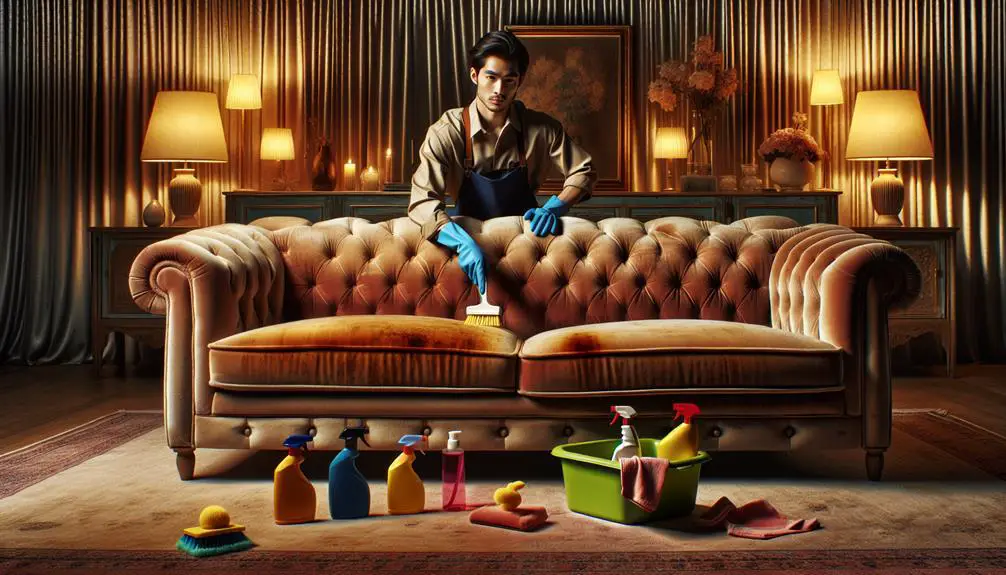I've always found velvet a bit tricky when it comes to cleaning. Its lush texture seems to attract dust and dirt like a magnet, and don't even get me started on spills! While some folks swear it's a nightmare to maintain, I've heard others say that with the right techniques, it's not so bad. It's got me wondering whether the type of velvet makes a difference, or if there are some insider tips I'm missing out on. What's your take on this? Have you found a foolproof method or a particular product that works wonders on velvet?
Table of Contents
Key Takeaways
- Velvet cleaning difficulty varies by type; synthetic is easier to clean than silk or cotton.
- Regular dusting and gentle vacuuming are necessary for routine velvet maintenance.
- Immediate blotting of spills is crucial to prevent stain setting in velvet fabrics.
- Professional cleaning is recommended for delicate velvet types to prevent damage.
- Always check care labels for specific cleaning instructions tailored to the velvet type.
Understanding Velvet Material
To truly grasp why cleaning velvet might be tricky, one must first understand what velvet is. Velvet is a type of woven fabric where the threads are evenly distributed with a short, dense pile, giving it that distinctive soft feel. What complicates things is the method of velvet production. It involves two layers of fabric being woven simultaneously, which are then cut apart to create the pile effect. This process makes velvet particularly delicate and not as durable as other fabrics.
Because of this unique production method, velvet's durability is often questioned. It doesn't bounce back easily from compression, and heavy use can lead to visible wear and tear. When it comes to cleaning, this lack of durability means you can't just toss it in the washing machine or scrub it aggressively. The fibers can get crushed, and any harsh treatment might ruin its elegant appearance.
Types of Velvet Fabrics
Velvet fabrics come in various types, each with its unique texture and care requirements. Understanding the differences is key to mastering their maintenance. Let's explore the main types and discuss some velvet production methods along with velvet durability concerns.
Firstly, there's silk velvet, prized for its softness and sheen but notorious for its delicacy. This type demands careful handling, particularly because it's less durable and more susceptible to damage from regular wear or improper cleaning. Silk velvet is traditionally woven, which contributes to its luxurious feel but also to its higher price and maintenance challenges.
Another popular type is cotton velvet. It's a bit more durable than silk and still offers a lovely soft texture. The production of cotton velvet often involves a pile weave technique, making it thicker and better suited for items that require more robust use, like upholstery.
Synthetic velvets, such as those made from polyester, offer a more affordable and resilient alternative. These are produced using different methods, like knit construction, which enhance the fabric's durability and reduce concerns over wear and tear. They're easier to care for and still provide that characteristic plush feel, making them a versatile choice for both fashion and home decor.
Each type requires a unique approach to cleaning and care, aligning with its specific properties and production background.
Common Velvet Cleaning Myths
Many people believe that you can't clean velvet with water, but that's actually a myth. Let's clear up some common misconceptions about cleaning this luxurious fabric.
First off, the origin of this myth likely stems from velvet's historical use in clothing and furnishings, prized for its rich texture and depth of color. Traditional velvet was made from silk, which can be quite delicate when wet. This has led to the widespread belief that all velvet must be handled similarly. However, modern velvets often blend synthetic fibers, making them more durable and less finicky about water.
Another prevalent myth is that velvet always requires dry cleaning. While it's true that some types of velvet benefit from professional care, not all velvet demands such treatment. Here's what you need to know:
- Check the Label: Always look for care instructions specific to your velvet item.
- Test First: Before applying any cleaning method, test on a small, inconspicuous area.
- Consider Material: Synthetic velvets can often handle gentle washing, while pure silk or velvet may need more careful handling.
Understanding these points helps in mastering velvet care and debunking the myths surrounding its maintenance.
Immediate Spill Response Tips
When you accidentally spill something on velvet, the first thing I do is blot the spill quickly with a soft cloth; this helps prevent the liquid from soaking in.
I'm careful to choose the right cleaning agents because some can be too harsh for delicate velvet.
It's also important to act fast to prevent the stain from setting into the fabric.
Blotting Fresh Spills Quickly
If you spill something on velvet, it's important to blot the area quickly with a clean, dry cloth. Acting fast minimizes the stain's penetration, preserving the fabric's integrity. Here's how I handle it:
- Immediate Action: As soon as the spill occurs, I blot—never rub—to avoid pushing the spill deeper into the fibers.
- Spill Absorption Techniques: I use gentle patting motions with a high-absorbency cloth to lift as much liquid as possible.
- Colorfastness Testing: Before using any cleaning solution, even plain water, I always test on an inconspicuous area to make sure it doesn't alter the fabric's color.
Handling velvet with care guarantees it remains luxurious and durable, prepared for any mishaps with minimal fuss.
Selecting Appropriate Cleaning Agents
After blotting the spill, I carefully select a cleaning agent that's safe and effective for velvet. It's important to pick products that minimize chemical risks and environmental impact. I usually opt for mild, water-based cleaners without harsh chemicals. These are gentle on the fabric and less harmful to the planet.
I avoid anything too abrasive or containing bleach, as these can damage the plush texture of velvet and pose unnecessary chemical risks.
I also consider homemade solutions like a mix of mild dish soap and water. This approach reduces the environmental impact further and keeps my velvet looking great. It's all about finding that balance between effectiveness and safety, both for the fabric and our environment.
Preventing Stain Settling
To prevent stains from setting into velvet, act quickly by gently blotting the spill with a soft cloth. Avoid rubbing as this can damage the fabric's delicate surface. Here's a quick guide to keep your velvet looking pristine:
- Apply Stain Repellents: After colorfast testing, apply a suitable stain repellent to help shield your velvet from spills.
- Immediate Blotting: Always have a soft cloth handy for immediate spill absorption.
- Professional Advice: For stubborn stains, consult a professional cleaner who specializes in velvet.
Routine Velvet Maintenance
Keeping velvet looking its best involves regular maintenance steps. Dust accumulation isn't just unsightly; it can also embed dirt into the fabric if not addressed promptly. I find that a weekly dusting using a soft cloth or a brush specifically designed for velvet helps lift and remove surface dust. For deeper dust, I use a vacuum with a brush attachment on a low setting to avoid damaging the fabric's delicate fibers.
Besides dust, I also watch out for light exposure. Velvet can fade if it's exposed to too much direct sunlight. To prevent this, I rotate my velvet furnishings periodically and use curtains or blinds to control the amount of natural light in the room. This helps maintain the rich color and texture of the fabric.
In my routine, I also give my velvet items a quick once-over to check for any loose threads or uneven wear. If I spot any, I address them immediately to prevent further damage. Remember, small maintenance steps can greatly extend the life and look of your velvet, making it well worth the effort.
Deep Cleaning Velvet Furniture
Occasionally, velvet furniture requires more than just routine maintenance; a thorough deep cleaning can rejuvenate its appearance to a great extent. When it's time to really dive deep, you've got to contemplate a few specialized methods that guarantee your velvet stays lush without getting damaged.
First off, steam treatment is a real game changer. It's gentle yet effective, lifting dirt and reducing odors without the harshness of traditional cleaning methods. Here's how I tackle deep cleaning:
- Vacuum First: Always start by vacuuming with a soft brush attachment. This removes surface dirt and debris and prepares the velvet for deeper cleaning.
- Steam Treatment: Using a garment steamer or a steam cleaner designed for upholstery, carefully steam at a distance to avoid saturating the fabric. This helps relax the fibers and lift ingrained dirt.
- Spot Cleaning: For any stubborn stains, I use a specific velvet cleaner and apply it with a soft cloth, dabbing gently rather than rubbing.
After steaming, I sometimes follow up with Ultraviolet sanitization. This step isn't just for show; it kills off any lingering bacteria or allergens, making the furniture not only look clean but also be genuinely hygienic. Plus, it gives me peace of mind, which is priceless!
Washing Velvet Clothing
While deep cleaning velvet furniture involves methods like steaming and spot treatment, washing velvet clothing demands its own set of careful steps. First off, always check the care label. Most velvet garments require dry cleaning to maintain their texture and color depth. This isn't just a suggestion—it's a necessity if you want to keep your pieces looking pristine.
I've learned that increasing the dry cleaning frequency can extend the life of velvet apparel. However, you've got to balance this with wear considerations. Frequent cleaning can be harsh on fabric, so I only send my velvet to the cleaners when absolutely necessary or after several wears. This strategy helps in managing both upkeep and costs effectively.
Moreover, I'm particularly cautious about color fading concerns. Velvet, especially rich, deep colors, are prone to losing their vibrancy when washed incorrectly. To avoid this, I opt for a reputable cleaner who knows their way around delicate fabrics. At home, I avoid exposing my velvet items to direct sunlight, which can also lead to fading. By taking these steps, I make sure my velvet clothing remains as luxurious as when I first bought it.
Professional Cleaning Options
I've explored several professional cleaning options to guarantee my velvet garments are handled with care. While DIY methods have their charm, when it comes to preserving the longevity and luster of velvet, professional care can make a world of difference. Here's why I lean towards specialists for this delicate task:
- Expertise in Fabric Care: Professionals possess the specific knowledge needed to treat different types of velvet, whether silk velvet or crushed velvet, without damaging the fibers.
- Advanced Techniques: Many dry cleaners offer steam cleaning, which is ideal for velvet. This method helps maintain the fabric's texture and sheen without using excessive water or harsh chemicals that could lead to shrinkage or fading.
- Tailored Advice: Beyond just cleaning, professionals can provide personalized recommendations on maintaining velvet's appearance post-cleaning.
Opting for professional cleaning might seem pricier compared to at-home methods, but it's a worthwhile investment to keep velvet looking impeccable. They use specialized equipment and are trained to handle delicate materials, ensuring that each garment gets the care it needs. This peace of mind is what keeps me going back; knowing my velvet is in expert hands makes all the difference.
Storing Velvet Items Properly
After guaranteeing my velvet items are cleaned by professionals, I make sure they're stored correctly to maintain their condition. Proper storage is essential not only for preserving the fabric's quality but also for minimizing its climate impact over time.
I start by choosing the right spot for storage. Velvet, being sensitive to light and moisture, needs a cool, dark, and dry place. Exposure to sunlight can fade the colors, while humidity can lead to mildew. A closet away from direct sunlight and away from bathroom walls is ideal.
Next, I focus on how to hang or fold the velvet. I use padded hangers for velvet clothing to avoid creases and ensure fabric breathability. The plush nature of velvet means it needs air to keep from becoming musty. For items that are better stored folded, I place acid-free tissue paper between the folds to prevent crushing the pile, and I never stack heavy items on top of velvet.
Velvet Care Mistakes to Avoid
When it comes to velvet, I've learned the hard way that ignoring the care label is a big no-no. I used to grab any old cleaner, but using the wrong products can really mess up the fabric.
Also, I can't stress enough how important regular maintenance is to keep it looking great.
Ignoring Manufacturer's Cleaning Instructions
One common mistake in velvet care is ignoring the manufacturer's cleaning instructions, which often leads to damage. Manufacturer warnings aren't just recommendations; they're vital for maintaining the integrity of your velvet items. The importance of following these instructions can't be overstated.
Here's why adhering to the guidelines is key:
- Preserve Fabric Quality: Ignoring instructions can result in irreversible fabric damage.
- Avoid Discoloration: Improper cleaning methods often lead to fading or staining.
- Maintain Durability: Proper care extends the life of velvet products significantly.
I've learned it's best to treat these guidelines as gospel. After all, who knows the fabric better than those who made it? Trust me, sticking to the book pays off in the long run.
Using Wrong Cleaning Products
Besides following manufacturer's guidelines, it's also crucial to use the right cleaning products for velvet to avoid damaging this delicate fabric.
I've learned the hard way that choosing the wrong cleaners can't only ruin the lush texture of velvet but also raise concerns about product toxicity and ecological impact. Harsh chemicals can degrade velvet fibers, while eco-unfriendly options contribute to wider environmental harm.
I stick to mild, eco-conscious products specifically recommended for velvet. These selections guarantee I'm not introducing harsh elements into my home or harming the planet. It's a simple switch that protects both my favorite velvet pieces and the environment.
Overlooking Routine Maintenance
Neglecting regular maintenance can quickly turn your plush velvet into a lackluster disappointment. It's easy to overlook the simple checks that keep velvet looking its best. But as someone who's made the mistake before, trust me, you don't want to skip these steps. Neglected inspections and missed assessments can escalate into bigger problems, like irreversible fabric damage.
Here's a quick list to keep you on track:
- Weekly Dusting: Prevent dust build-up that can dull velvet's shine.
- Monthly Vacuuming: Use an upholstery attachment to gently remove deeper grit.
- Immediate Spot Cleaning: Tackle spills right away to avoid set-in stains.
Staying diligent with these routines will make sure your velvet stays sumptuous and rich, just like when you first bought it.
Frequently Asked Questions
Can Velvet Be Ironed or Steamed Safely?
Yes, I can iron or steam velvet, but I must be careful. I always check the fabric's sensitivity and adjust the heat settings accordingly to avoid damage. It's all about the right technique.
How Does Sunlight Exposure Affect Velvet Fabric?
Sunlight exposure can cause color fading and texture alteration in velvet. I've noticed it can weaken the fabric, making it less plush. It's best to keep velvet out of direct sunlight to avoid damage.
Are There Eco-Friendly Methods for Cleaning Velvet?
Yes, I've found green detergents and a vinegar solution work well for cleaning velvet. They're eco-friendly and effective, especially when I carefully follow the product instructions to avoid damaging the fabric.
How Do I Restore Crushed or Matted Velvet?
To restore crushed or matted velvet, I've found velvet brushing really effective. Sometimes, professional flattening is necessary for stubborn areas. This approach guarantees my velvet items regain their luxurious texture and appearance effectively.
Can Pets Damage Velvet Fabrics, and How to Prevent It?
Pets can definitely harm velvet. To prevent damage, I'd recommend frequent pet grooming and using protective covers on your velvet furniture. It's a simple solution that keeps everything looking great!
- How to Unshrink a Child’s Shrunken Outfit? - June 9, 2025
- Can You Prevent Shrinkage in Organic Cotton? - June 9, 2025
- What’s the Difference Between Relaxation and Felting Shrinkage? - June 9, 2025







